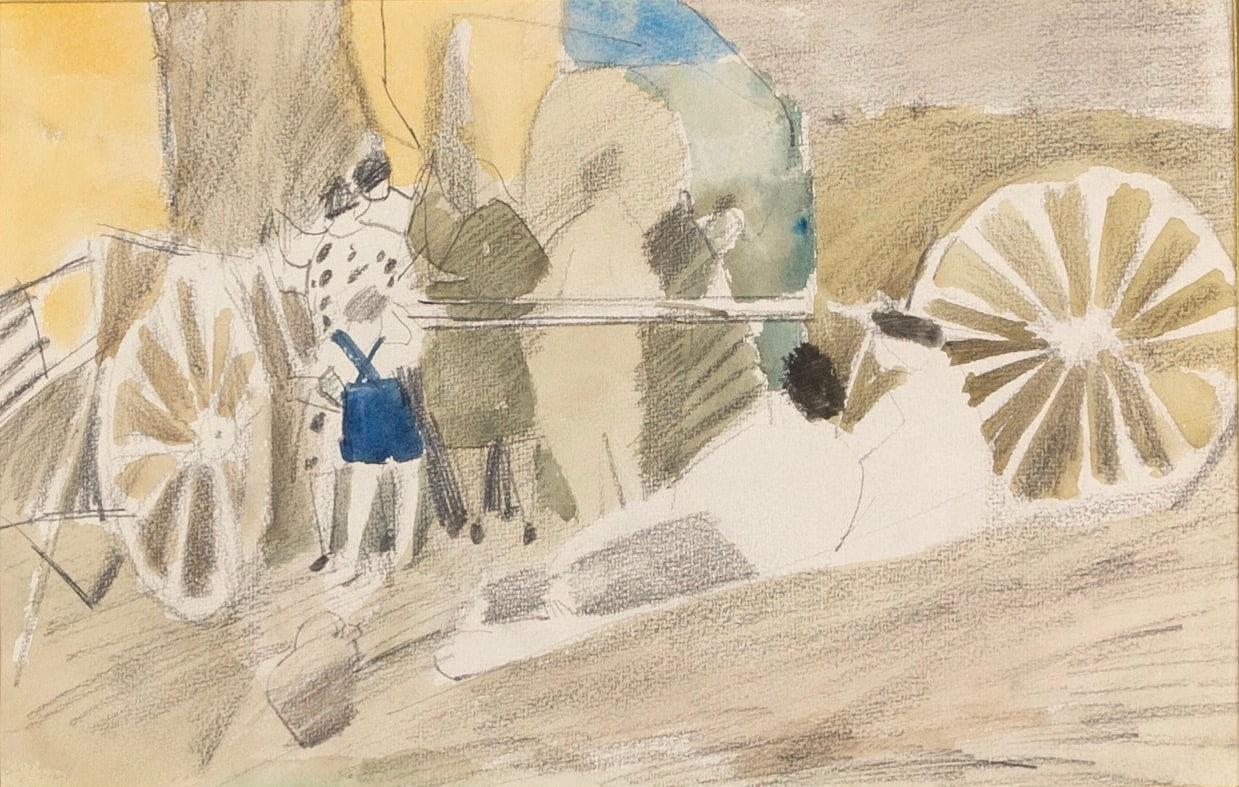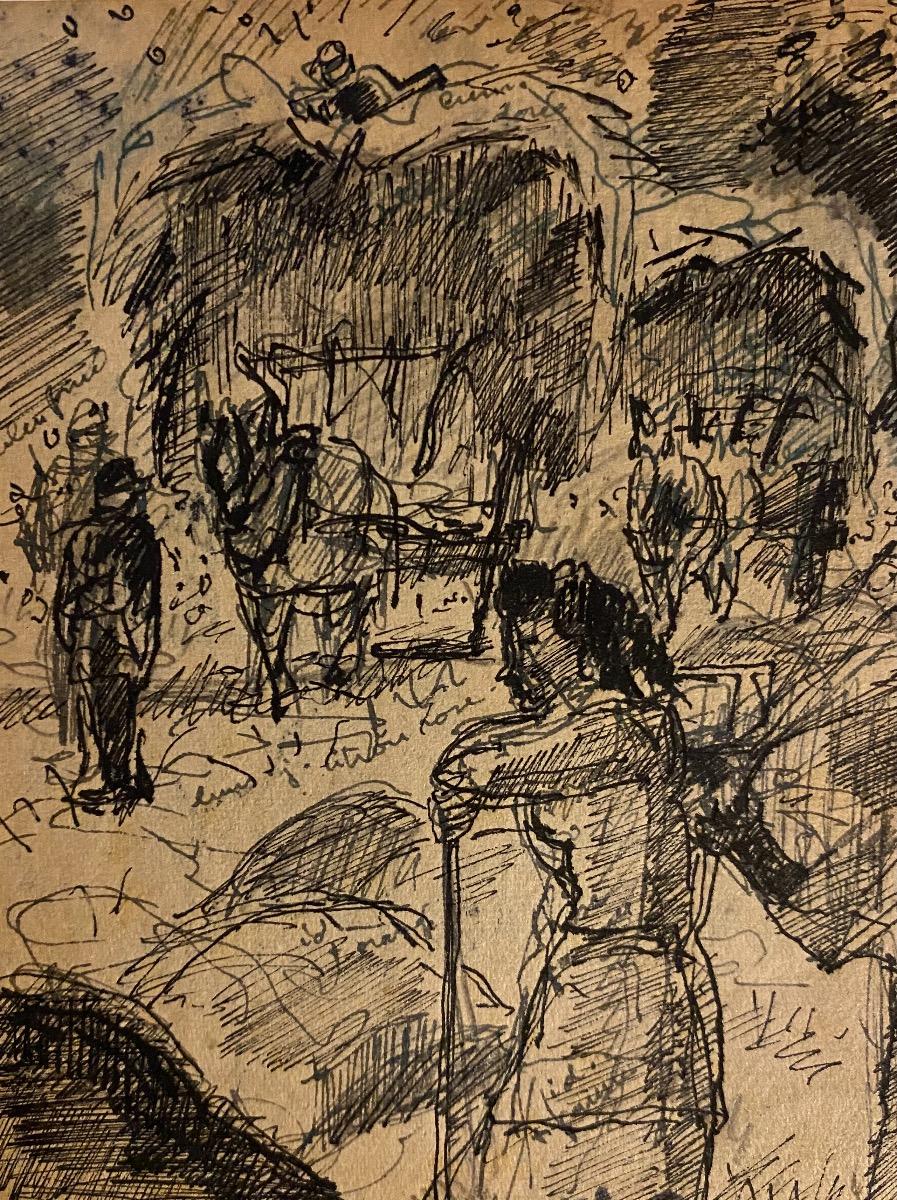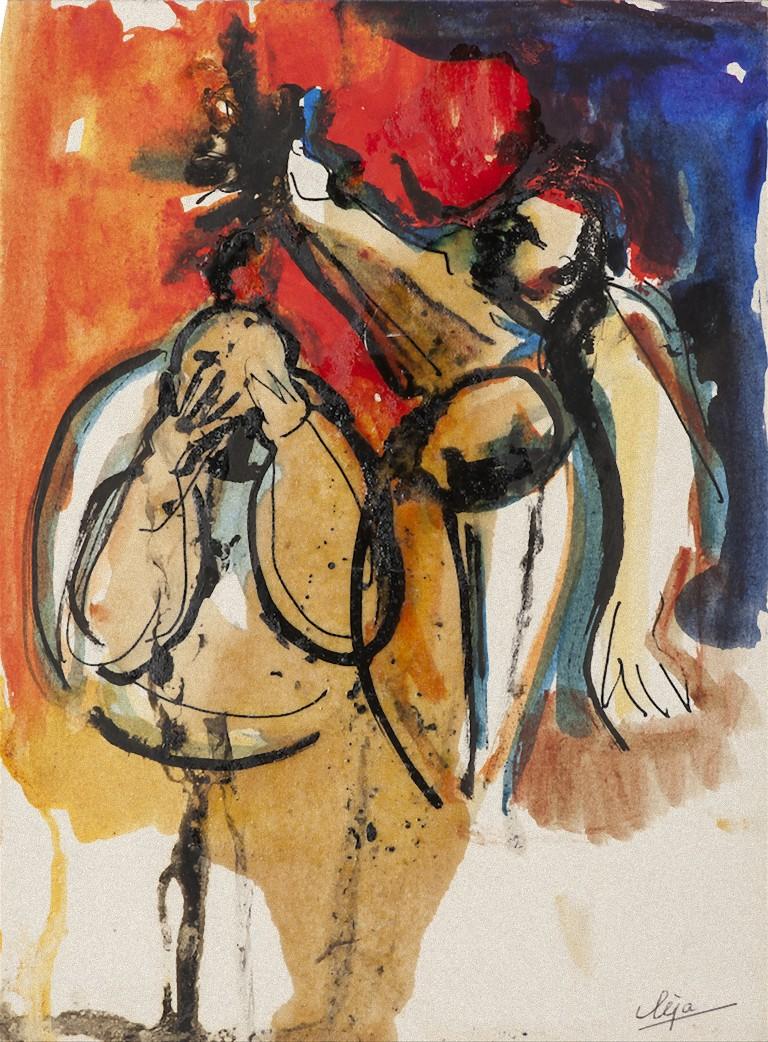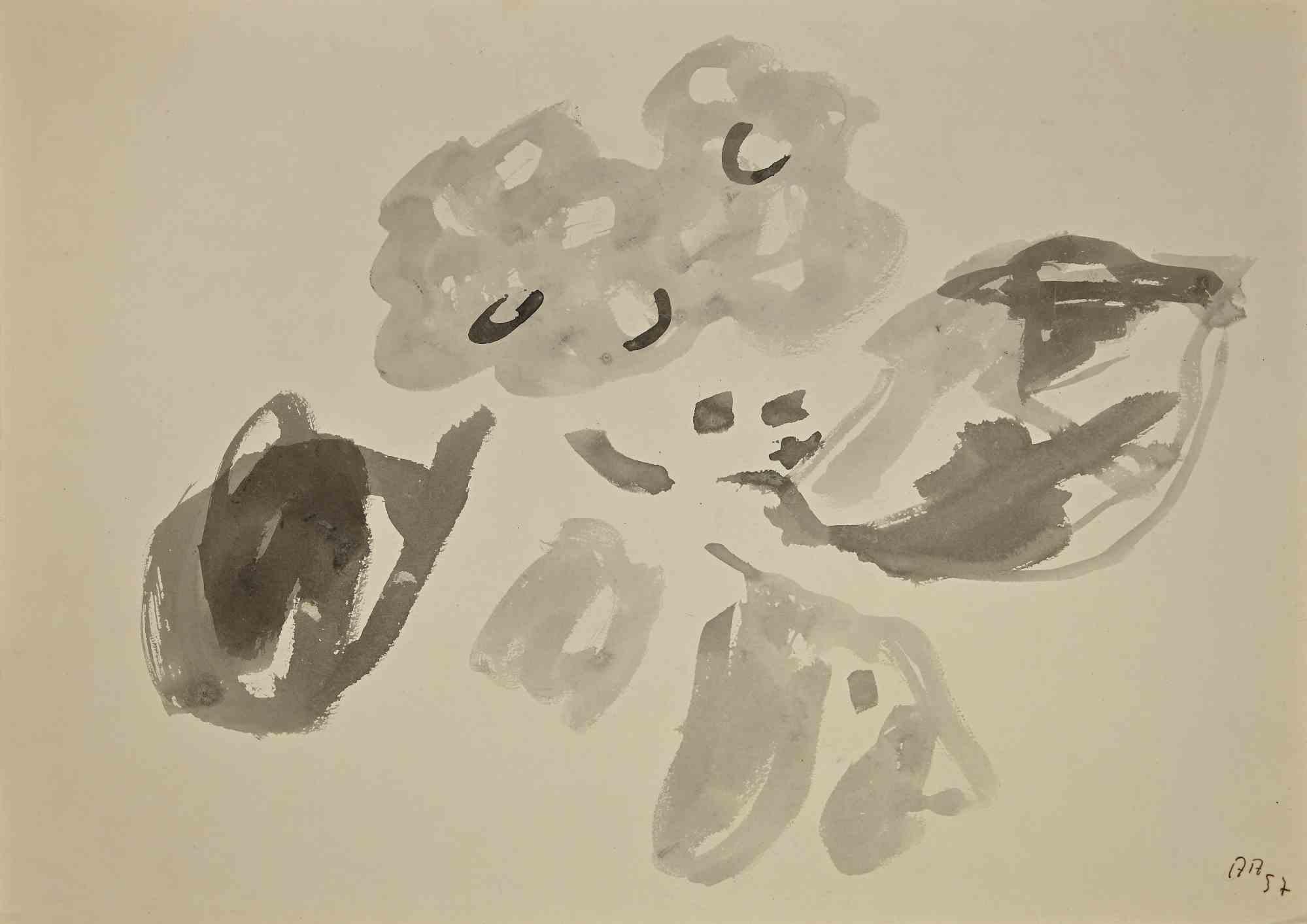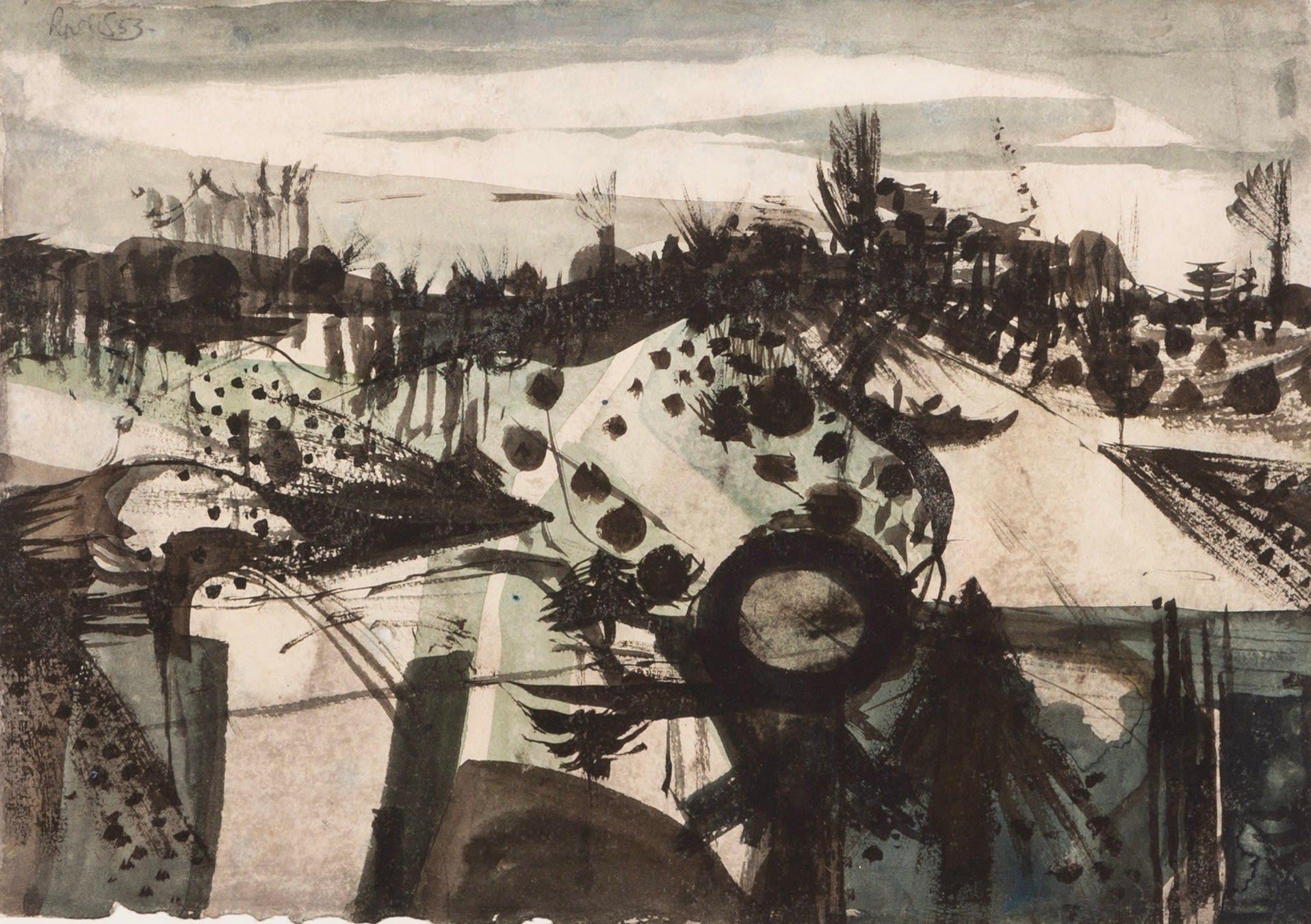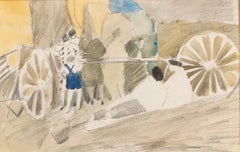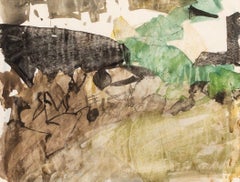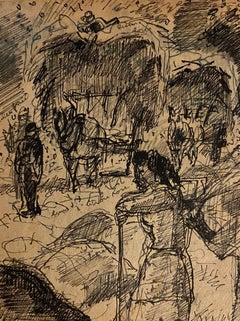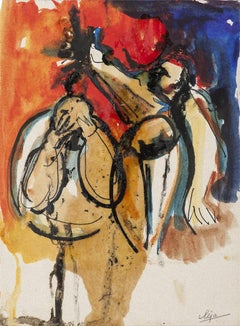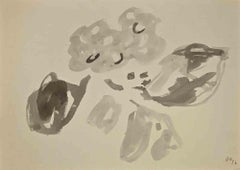Items Similar to Wagons in the Field, Poland, Watercolour and Charcoal Painting, 1958
Want more images or videos?
Request additional images or videos from the seller
1 of 3
UnknownWagons in the Field, Poland, Watercolour and Charcoal Painting, 19581958
1958
$2,696.99
£1,950
€2,304.16
CA$3,727.64
A$4,145.38
CHF 2,175.77
MX$50,550.95
NOK 27,497.44
SEK 25,779.95
DKK 17,198
About the Item
Wagons in the Field, Poland, Watercolour and Charcoal Painting, 1958
Additional information:
Medium: Watercolour and charcoal
20.6 x 32.3 cm
8 1/8 x 12 3/4 in
Tadeusz Piotr (Peter) Potworowski was a Polish abstract and figurative painter who lived and exhibited in Paris, Poland, Sweden and England.
Potworowski was born in Warsaw in 1898. After serving in the First World War, Potworowski enrolled at the Warsaw University of Technology to study architecture, though his studies were halted by the Bolshevik campaign. After the end of the Polish-Soviet War in 1921, Potworowski returned to Warsaw and began to study art at the school of Konrad Krzyżanowski. By the following year, he had taken a place at the Academy of Fine Arts in Krakow, where he studied under Józef Pankiewicz. It was Pankiewicz who incorporated Potworowski into the Paris Commute, or Kapists, a group of Polish artists who travelled to the French capital in 1924.
During his seven years in Paris he became personally acquainted with Pablo Picasso, Pierre Bonnard, Jean Cocteau, Constantin Brancusi and attended for a short time Fernand Léger's studio. It was through this job that he met his first wife Magdalena Mańkowska, a student of anthropology in Paris. After marrying in France, and visiting Britain in 1928, the couple returned to Poland in 1930, where their first son John was born.
In 1931, Warsaw was the locale of the first Kapists exhibition, entitled New Generation, which took place at the Artist's Club, Hotel Polonia, and the Institute of Art Propaganda. Here, Potworowski received a prize for his painting Three Women in the Interior. The following year, he held his first solo exhibition at the Makowski Salon in Poznań. This success was sustained through 1937 when the artist received a silver medal at the International Exhibition of Art and Technology in Paris, as well as the award from the Minister of Foreign Affairs. After this strong development, Potworowski had a travelling solo exhibition arranged, held in 1938 at the Institute of Propaganda of Art in Warsaw and then in Lviv.
Following the invasion of Poland in 1939, Potworowski escaped to Sweden via Lithuania. It was from here that the artist, with his wife and two young children, made his way to Britain, arriving in 1943. After serving in Scotland, Potworowski settled in London, and in January 1946, an exhibition of 33 of his works was held at the Redfern Gallery. This was followed by regular exhibitions with the Redfern, Gimpel Fils (1948 onwards) and The London Group, to which he was elected a member in 1949. He was also the president of the Association of Polish Artists and published regularly in the monthly magazine "Nowa Polska".
Potworowski's teaching career included eight years as Professor of Painting at the Bath Academy of Art, Corsham (1949-57), where he had considerable European influence, specifically on abstraction, and was acknowledged by contemporaries including Peter Lanyon, Bryan Wynter, Terry Frost and Adrian Heath. Making his way to Cornwall, Potworowski took a studio at Sancreed near Penzance. The landscape here invigorated his work and he painted extensively in the Duchy. In 1956, Potworowski was elected to the Royal West of England Academy and in 1960 he won an award at the 30th Venice Biennale.
In the relative peace of the 1950s, Potworowski travelled and painted extensively with his professional and romantic partner Doreen Heaton Potworowska, whom he met in 1952 while teaching at Corsham. They visited much of Europe including in France, Spain and Italy, before returning to his native Poland in 1958, where the artist spent the last four years of his life. He died in Warsaw in 1962. In 1996 a major retrospective exhibition was held at the Polish National Gallery of Contemporary Art in Warsaw.
Peter Potworowski's work is held extensively in notable private and public collections internationally, including the Victoria Art Gallery, Royal West of England Academy and the Tate.
- Creation Year:1958
- Dimensions:Height: 8.13 in (20.66 cm)Width: 12.75 in (32.39 cm)
- Medium:
- Period:
- Condition:
- Gallery Location:Kingsclere, GB
- Reference Number:1stDibs: LU2718214575782
About the Seller
No Reviews Yet
Vetted Professional Seller
Every seller passes strict standards for authenticity and reliability
Established in 2010
1stDibs seller since 2024
41 sales on 1stDibs
Typical response time: 8 hours
- ShippingRetrieving quote...Shipping from: Kingsclere, United Kingdom
- Return Policy
Authenticity Guarantee
In the unlikely event there’s an issue with an item’s authenticity, contact us within 1 year for a full refund. DetailsMoney-Back Guarantee
If your item is not as described, is damaged in transit, or does not arrive, contact us within 7 days for a full refund. Details24-Hour Cancellation
You have a 24-hour grace period in which to reconsider your purchase, with no questions asked.Vetted Professional Sellers
Our world-class sellers must adhere to strict standards for service and quality, maintaining the integrity of our listings.Price-Match Guarantee
If you find that a seller listed the same item for a lower price elsewhere, we’ll match it.Trusted Global Delivery
Our best-in-class carrier network provides specialized shipping options worldwide, including custom delivery.More From This Seller
View AllWagons in the Field, Poland by Peter Potworowski, Watercolour Landscape, 1958
By Peter Potworowski
Located in Kingsclere, GB
Wagons in the Field, Poland
Category
20th Century Landscape Drawings and Watercolors
Materials
Charcoal, Watercolor
Pastoral Landscape, Gouache and Watercolour Painting by Alan Reynolds, 1953
By Alan Reynolds
Located in Kingsclere, GB
Pastoral Landscape, Gouache and Watercolour Painting by Alan Reynolds, 1953
Additional information:
Medium: Gouache and watercolour
19.5 x 27.5 cm
7 5/8...
Category
20th Century Abstract Drawings and Watercolors
Materials
Gouache
Coastal Scene, Gouache Painting by Peter Potworowski, 1950s circa
Located in Kingsclere, GB
Coastal Scene, Gouache Painting by Peter Potworowski, 1950s circa
Additional information:
Medium: Gouache
17 x 21.5 cm
6 3/4 x 8 1/2 in
Tadeusz Piotr (Peter) Potworowski was a Polish abstract and figurative painter who lived and exhibited in Paris, Poland, Sweden and England.
Potworowski was born in Warsaw in 1898. After serving in the First World War, Potworowski enrolled at the Warsaw University of Technology to study architecture, though his studies were halted by the Bolshevik campaign. After the end of the Polish-Soviet War in 1921, Potworowski returned to Warsaw and began to study art at the school of Konrad Krzyżanowski. By the following year, he had taken a place at the Academy of Fine Arts in Krakow, where he studied under Józef Pankiewicz. It was Pankiewicz who incorporated Potworowski into the Paris Commute, or Kapists, a group of Polish artists who travelled to the French capital in 1924.
During his seven years in Paris he became personally acquainted with Pablo Picasso, Pierre Bonnard, Jean Cocteau, Constantin Brancusi and attended for a short time Fernand Léger's studio. It was through this job that he met his first wife Magdalena Mańkowska, a student of anthropology in Paris. After marrying in France, and visiting Britain in 1928, the couple returned to Poland in 1930, where their first son John was born.
In 1931, Warsaw was the locale of the first Kapists exhibition, entitled New Generation, which took place at the Artist's Club, Hotel Polonia, and the Institute of Art Propaganda. Here, Potworowski received a prize for his painting Three Women in the Interior. The following year, he held his first solo exhibition at the Makowski Salon in Poznań. This success was sustained through 1937 when the artist received a silver medal at the International Exhibition of Art and Technology in Paris, as well as the award from the Minister of Foreign Affairs. After this strong development, Potworowski had a travelling solo exhibition arranged, held in 1938 at the Institute of Propaganda of Art in Warsaw and then in Lviv.
Following the invasion of Poland in 1939, Potworowski escaped to Sweden via Lithuania. It was from here that the artist, with his wife and two young children, made his way to Britain, arriving in 1943. After serving in Scotland, Potworowski settled in London, and in January 1946, an exhibition of 33 of his works was held at the Redfern Gallery. This was followed by regular exhibitions with the Redfern, Gimpel Fils (1948 onwards) and The London Group, to which he was elected a member in 1949. He was also the president of the Association of Polish Artists and published regularly in the monthly magazine "Nowa Polska".
Potworowski's teaching career included eight years as Professor of Painting at the Bath Academy of Art, Corsham (1949-57), where he had considerable European influence, specifically on abstraction, and was acknowledged by contemporaries including Peter Lanyon, Bryan Wynter...
Category
20th Century Abstract Paintings
Materials
Gouache
Cornish Coast, Gouache Painting by Peter Potworowski, 1952/3
Located in Kingsclere, GB
Cornish Coast, Gouache Painting by Peter Potworowski, 1952/3
Additional information:
Medium: Gouache
20.3 x 33 cm
8 x 13 in
Tadeusz Piotr (Peter) Potworowski was a Polish abstract and figurative painter who lived and exhibited in Paris, Poland, Sweden and England.
Potworowski was born in Warsaw in 1898. After serving in the First World War, Potworowski enrolled at the Warsaw University of Technology to study architecture, though his studies were halted by the Bolshevik campaign. After the end of the Polish-Soviet War in 1921, Potworowski returned to Warsaw and began to study art at the school of Konrad Krzyżanowski. By the following year, he had taken a place at the Academy of Fine Arts in Krakow, where he studied under Józef Pankiewicz. It was Pankiewicz who incorporated Potworowski into the Paris Commute, or Kapists, a group of Polish artists who travelled to the French capital in 1924.
During his seven years in Paris he became personally acquainted with Pablo Picasso, Pierre Bonnard, Jean Cocteau, Constantin Brancusi and attended for a short time Fernand Léger's studio. It was through this job that he met his first wife Magdalena Mańkowska, a student of anthropology in Paris. After marrying in France, and visiting Britain in 1928, the couple returned to Poland in 1930, where their first son John was born.
In 1931, Warsaw was the locale of the first Kapists exhibition, entitled New Generation, which took place at the Artist's Club, Hotel Polonia, and the Institute of Art Propaganda. Here, Potworowski received a prize for his painting Three Women in the Interior. The following year, he held his first solo exhibition at the Makowski Salon in Poznań. This success was sustained through 1937 when the artist received a silver medal at the International Exhibition of Art and Technology in Paris, as well as the award from the Minister of Foreign Affairs. After this strong development, Potworowski had a travelling solo exhibition arranged, held in 1938 at the Institute of Propaganda of Art in Warsaw and then in Lviv.
Following the invasion of Poland in 1939, Potworowski escaped to Sweden via Lithuania. It was from here that the artist, with his wife and two young children, made his way to Britain, arriving in 1943. After serving in Scotland, Potworowski settled in London, and in January 1946, an exhibition of 33 of his works was held at the Redfern Gallery. This was followed by regular exhibitions with the Redfern, Gimpel Fils (1948 onwards) and The London Group, to which he was elected a member in 1949. He was also the president of the Association of Polish Artists and published regularly in the monthly magazine "Nowa Polska".
Potworowski's teaching career included eight years as Professor of Painting at the Bath Academy of Art, Corsham (1949-57), where he had considerable European influence, specifically on abstraction, and was acknowledged by contemporaries including Peter Lanyon, Bryan Wynter...
Category
20th Century Abstract Paintings
Materials
Gouache
Study for Men in the Trench, Pen, Ink & Watercolour on Paper Painting 1950 circa
By Reginald Brill
Located in Kingsclere, GB
Study for Men in the Trench, Pen, Ink & Watercolour on Paper Painting 1950 circa
Additional information:
Medium: Pen, ink and watercolour on paper
11 3/4 x 26 in
29.8 x 68.5 cm
Reginald " Reggie" Brill was a versastile 20th century artist and teacher.
Brill was born in London in 1902 and spent his early childhood there and in Yorkshire. By the time of the First World War, at the age of 13, he was living in lodgings in London, working in a City office and attending St Martins School of Art in the evenings. Considering his lack of education, winning a scholarship to The Slade (now part of University College London) in 1921 where he studied under Henry Tonks for three years, was a huge achievement.
On leaving The Slade he found patronage in Lincolnshire, but by the time of the General Strike (1926) he had returned to London and was working on Lansbury's Labour Weekly. He married Rosalie, also an artist, and in 1927 won the Prix de Rome in Decorative Painting. Following two years at The British School in Rome, Brill went to teach at Blackheath School of Art. During 1930 he spent three months painting in Egypt and it was there that he met Col. T G Gayer-Anderson, one of the twin brothers who were to bequeath The Little Hall in Lavenham as a hostel for art students. It was there that Brill retired to act as warden, thus continuing his nurturing of art students until his death in 1972.
Brill took up his appointment at The School of Art, Kingston upon Thames in January 1934. It was situated in the Technical Institute (Kingston Hall Road) and Brill found it bohemian and disorganised. He proceeded to inject enthusiasm, order and discipline. Within 5 years of his appointment a purpose-built School of Art was opened in Knights Park. It remained open throughout the war and by 1945 there was a waiting list for places. Under the skilled and totally dedicated direction of Brill, Kingston School of Art became established with national reputation for excellence. In 1961 Sir Charles Wheeler opened the new building at Knights Park. Costing £100,000, this more than doubled the size of the Art School.
Brill, was a well-known figure in Kingston. His eloquence made him popular as a guest speaker and his promotion of Art and Design stretched well beyond the doors of Knights Park. Apart from establishing two of the main buildings which makeup what is now known as the Faculty of Design, one of the most visible local contributions he made was the setting up of a topographical collection of paintings depicting Kingston, which has since become known as The Brill Collection at Kingston Museum. Brill gained huge respect and admiration from the hundreds of pupils who studied at Kingston during his 30-year leadership.
He published two books, Modern Painting 1946 and Art as a Career 1962, both bearing a strong educational angle. He regularly exhibited along with leading artists of his era at The Royal Academy, both his paintings and his acutely observed drawings. All the while he was a prolific artist, although reading his diaries, intensely self-critical. His perfectionism, acute powers of observation and relentless research can be seen in his drawings, which via the media and methods he explored throughout his life reflect mid 20th century British Art at its most typical. His major series of work, known as 'The Martyrdom of Man', was carried on in parallel to his career as a teacher. These paintings reflect his care for fellow man and depict people at work, e.g., The Operation, The Jury, Linemen, Waiting Room and Rest, which recently sold at Sotheby’s and was specially restored for The Brill Retrospective. His smaller works also play with the theme of everyday events and communication amongst people, such as The Bull Ring and Market Place paintings.
Brill's name is associated particularly with human figure compositions, but he also worked on landscapes, portraits and details of plants, animals, interiors etc. As one would expect he moved from one media to another, and his unusual hand painted and cut paper mosaics...
Category
20th Century Figurative Drawings and Watercolors
Materials
Pen
Figures Talking, Oil on Paper Painting by Philip Jones, 1973
Located in Kingsclere, GB
Figures Talking, Oil on Paper Painting by Philip Jones 1933-2008, 1973
Additional information:
Medium: Oil on paper
55.9 x 76.2 cm
22 x 30 in
Signed, dated and titled
Philip Jones ...
Category
20th Century Abstract Paintings
Materials
Paper, Oil
You May Also Like
Wagons with Hay - Original Pen by Bertrand Mogniat-Duclos - Mid-20th Century
Located in Roma, IT
Wagons with hay is an original colored drawing in pen on ivory-colored paper, realized by Mogniat-Duclos Bertrand, a French painter.
In very good conditions. Image Dimensions: 13.5 ...
Category
Mid-20th Century Modern Figurative Drawings and Watercolors
Materials
Pen
Figures - Original Watercolor on Paper - Mid-20th Century
Located in Roma, IT
Figures is an original modern drawing in watercolor on paper realized by an Anonymous artist of the mid-20th Century.
Very good conditions.
The artwork represents two colorful figu...
Category
Mid-20th Century Modern Figurative Drawings and Watercolors
Materials
Watercolor
Watercolor Landscape - Scene of Workers and Family on a Farm
By Stephane Magnard
Located in Houston, TX
Vintage gouache of a colorful field scene in Madagascar, Africa, by French artist Stéphane Magnard (1917-2010), circa 1950.
Stéphane Magnard was the painter for the colonial govern...
Category
1950s Landscape Paintings
Materials
Watercolor, Paper, Gouache
Abstract Composition - Watercolor on paper - 1957
Located in Roma, IT
Abstract Composition is an original watercolored drawing on paper realized by a French Anonymous artist in 1957.
Dated on the lower.
Good conditions.
The delicate poetic expressio...
Category
1950s Modern Abstract Drawings and Watercolors
Materials
Watercolor
Landscape - Watercolor Drawing on Paper - 20th Century
Located in Roma, IT
Landscape is a watercolor drawing on paper realized by an artist of the 20th Century.
The state of preservation of the artwork is good.
Signed on the lower right but unreadable.
S...
Category
20th Century Figurative Drawings and Watercolors
Materials
Watercolor
Suburb. 1963, watercolor on paper, 27x38 cm
Located in Riga, LV
Suburb. 1963, watercolor on paper, 27x38 cm
Dzidra Bauma (1930)
Dzidra Bauma works in watercolor technique. She paint figural compositions, portraits, l...
Category
1960s Expressionist Landscape Paintings
Materials
Paper, Watercolor
$649 Sale Price
20% Off
